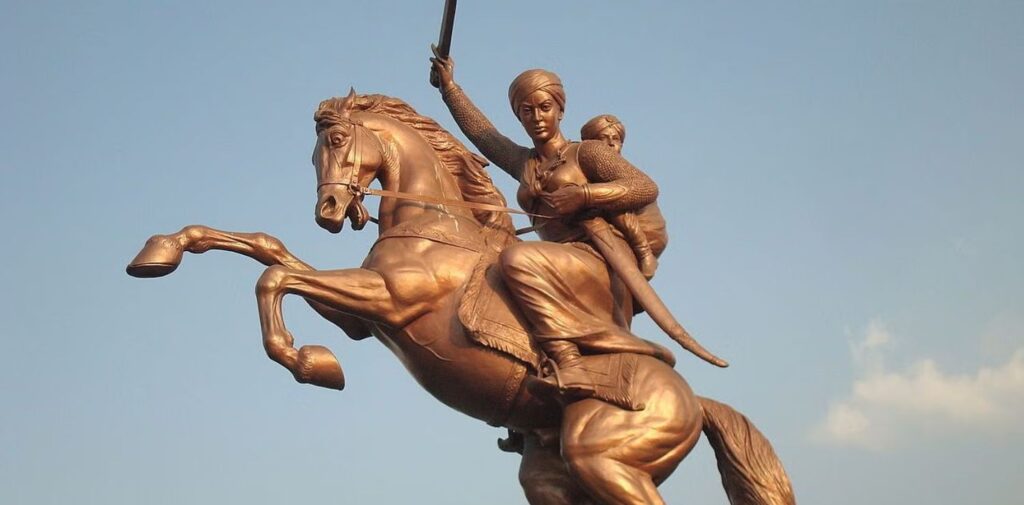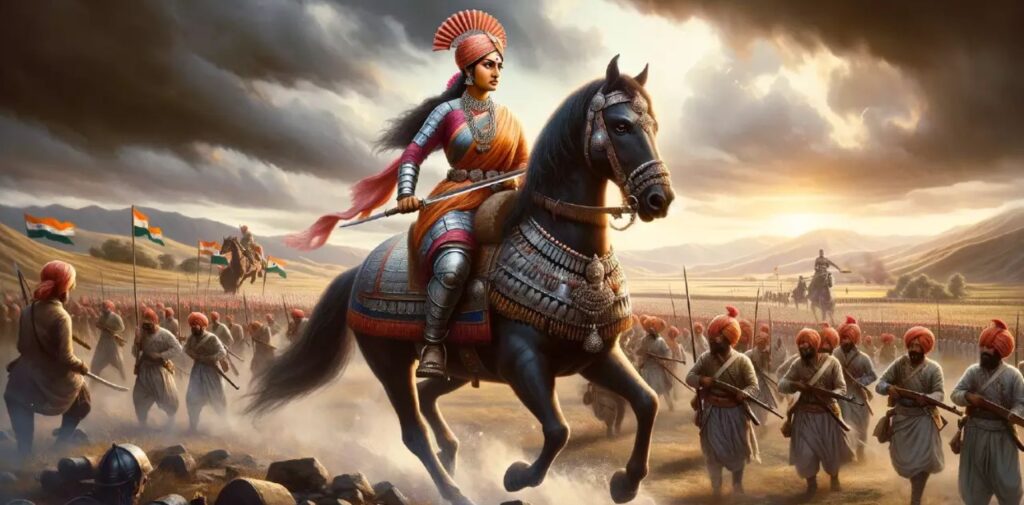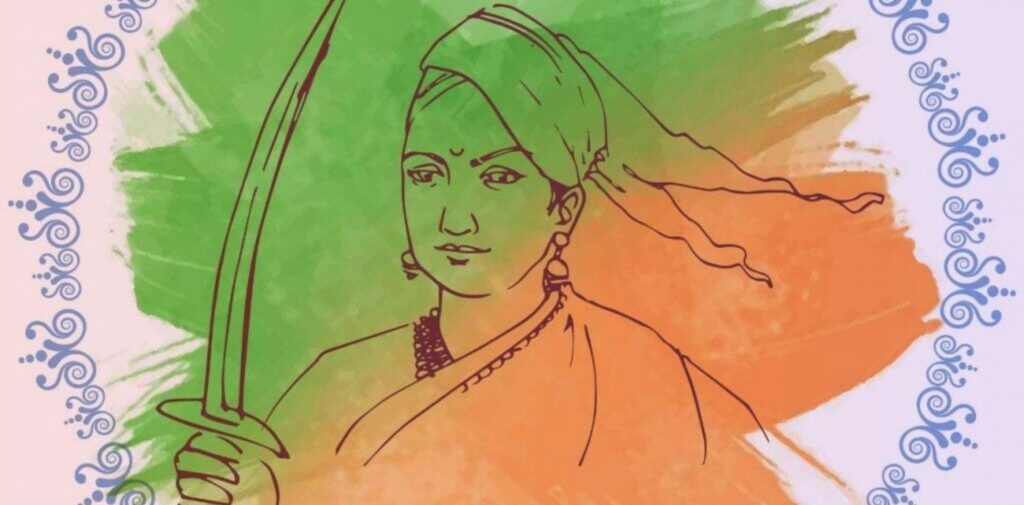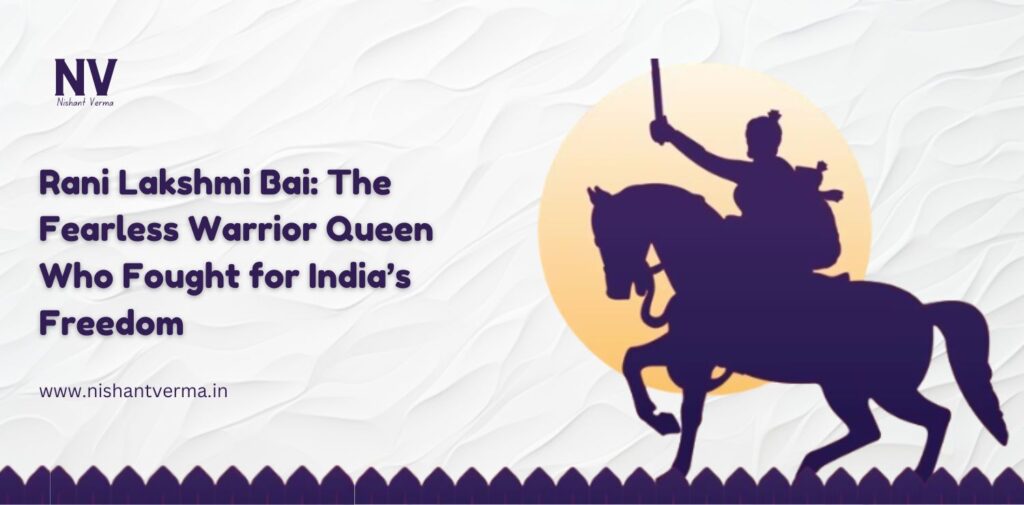On India’s Independence Day, it is essential to remember and honor the brave souls who fought relentlessly against colonial oppression, long before the official freedom struggle began. Among these valiant figures, Rani Lakshmi Bai, the Queen of Jhansi, stands out as a symbol of courage, resilience, and patriotism. Her contribution to India’s fight for freedom is both inspirational and unforgettable. As we celebrate our independence, it is crucial to reflect on her life, her struggles, and her unwavering commitment to the cause of liberating her beloved country from British rule.

Early Life and the Rise of a Warrior Queen
Rani Lakshmi Bai, born Manikarnika Tambe on November 19, 1828, in Varanasi, was destined for greatness from the very beginning. Her childhood was marked by unusual circumstances that shaped her into a warrior. Raised in a Brahmin family, she was affectionately known as Manu. After the death of her mother, she was brought up by her father, Moropant Tambe, who worked in the court of Peshwa Baji Rao II in Bithoor. The Peshwa, recognizing her potential, treated her as his daughter.
From a young age, Manikarnika displayed qualities of courage and leadership that set her apart from her peers. Unlike the traditional upbringing of girls in her time, she was trained in horse riding, sword fighting, and archery. These skills, which were uncommon for women in the 19th century, would later prove invaluable as she took on the role of a leader and warrior.
At the age of 14, she was married to Maharaja Gangadhar Rao Newalkar of Jhansi, and thus she became the Queen of Jhansi, taking on the name Lakshmi Bai. Her marriage marked the beginning of a new chapter in her life, but it also brought with it new challenges. Despite the difficulties, she rose to the occasion, taking on her responsibilities with grace and determination.

The Doctrine of Lapse and the Struggle for Jhansi
The turning point in Rani Lakshmi Bai’s life came with the death of her husband, Maharaja Gangadhar Rao, in 1853. The couple had adopted a son, Damodar Rao, as the rightful heir to the throne. However, the British East India Company, under the Doctrine of Lapse implemented by Governor-General Lord Dalhousie, refused to recognize the adopted heir. According to this policy, if a ruler died without a natural heir, their kingdom would be annexed by the British.
The British annexation of Jhansi was not just an act of political aggression; it was a direct affront to the sovereignty of the Indian rulers and an encroachment on their rights. Rani Lakshmi Bai, refusing to submit to this unjust policy, decided to take a stand. Her refusal to hand over Jhansi marked the beginning of her struggle against the British.
Rani Lakshmi Bai’s defiance of the British was not just a personal act of resistance; it was a statement against the broader imperialist policies that sought to undermine and exploit the native rulers of India. Her decision to fight back was rooted in a deep sense of justice and a commitment to protecting her kingdom and her people from foreign domination.
The Revolt of 1857: Rani Lakshmi Bai’s Leadership and Valor
The year 1857 marked a significant chapter in India’s history as the First War of Independence, also known as the Revolt of 1857, erupted across the country. Rani Lakshmi Bai emerged as one of the leading figures in this uprising. Her participation in the revolt was not just a reaction to the annexation of Jhansi but also a part of the larger resistance against British rule.
When the revolt broke out, Rani Lakshmi Bai found herself at the forefront of the battle. She assumed the role of a military leader, organizing her forces and fortifying the defenses of Jhansi. Under her command, the people of Jhansi showed tremendous courage and determination. The queen herself led her troops into battle, displaying exceptional bravery and tactical acumen.
One of the most notable battles was the Siege of Jhansi in 1858. The British forces, led by Sir Hugh Rose, laid siege to the fort of Jhansi. Despite being vastly outnumbered and outgunned, Rani Lakshmi Bai and her soldiers put up a fierce resistance. For several weeks, they held the British at bay, inflicting heavy casualties on the enemy. Her leadership during this time was nothing short of extraordinary. She not only inspired her troops but also demonstrated her prowess as a warrior, fighting alongside them on the battlefield.
Even when it became evident that Jhansi could not hold out against the British forces indefinitely, Rani Lakshmi Bai refused to surrender. Instead, she made a daring escape from the fort, along with her son, and continued to fight from the neighboring regions. Her resolve to keep fighting, even in the face of overwhelming odds, made her a symbol of resistance and a beacon of hope for the people of India.
The Battle of Gwalior and the Legacy of Rani Lakshmi Bai
After escaping from Jhansi, Rani Lakshmi Bai continued her resistance by joining forces with other rebel leaders, including Tatya Tope and the Nawab of Banda. Together, they aimed to recapture lost territories and strengthen the rebellion against the British. The alliance between these leaders was a significant moment in the revolt, as it demonstrated the unity and resolve of Indian leaders to fight against a common enemy.
One of the last and most crucial battles that Rani Lakshmi Bai fought was the Battle of Gwalior in June 1858. The fort of Gwalior was strategically important, and the rebels saw it as a stronghold that could potentially turn the tide of the revolt. Rani Lakshmi Bai led her forces into battle once again, displaying the same fearlessness and determination that had defined her previous engagements.
Unfortunately, despite her best efforts, the battle did not go in favor of the rebels. On June 18, 1858, Rani Lakshmi Bai was mortally wounded in combat. Even in her final moments, she remained steadfast, fighting to the last breath. Her death was a significant blow to the rebellion, but her legacy as a fearless leader and a symbol of resistance was immortalized in the annals of Indian history.
The British themselves acknowledged her bravery, with Hugh Rose reportedly referring to her as “the most dangerous of all Indian leaders.” Her courage and determination earned her the respect of both her allies and her adversaries, and her story continues to inspire generations of Indians.

Rani Lakshmi Bai’s Contribution to India’s Freedom Struggle
Rani Lakshmi Bai’s contribution to India’s freedom struggle goes far beyond her military exploits. She represented the indomitable spirit of resistance against foreign rule and the willingness to fight for justice and sovereignty. Her defiance of British authority was not just about protecting her own kingdom; it was about standing up against the larger injustices of colonialism.
Her role in the Revolt of 1857 also set the stage for future generations of freedom fighters. By challenging the might of the British Empire, she demonstrated that it was possible to resist and fight back, even in the face of overwhelming odds. Her example inspired many others to take up arms against the British in subsequent years, contributing to the eventual independence of India.
Furthermore, Rani Lakshmi Bai’s legacy has had a lasting impact on the way Indian women are perceived in the context of leadership and warfare. In a time when women were largely confined to domestic roles, she broke all stereotypes by leading armies and fighting on the front lines. Her bravery challenged the traditional norms and paved the way for women to be seen as equals in the struggle for independence and beyond.

The Undying Legacy of Rani Lakshmi Bai
As we celebrate India’s Independence Day, it is essential to remember the sacrifices and contributions of Rani Lakshmi Bai. Her life and her struggle are a testament to the fact that the fight for freedom was not just waged by men, but by women of extraordinary courage and resolve as well. She is not just a historical figure; she is a symbol of resistance, empowerment, and the unyielding spirit of freedom.
The legacy of Rani Lakshmi Bai continues to live on in various forms. Her story has been immortalized in literature, films, and folklore, ensuring that her bravery and sacrifice are remembered by future generations. She has become an icon of Indian nationalism, and her image as a warrior queen who fought against all odds remains a powerful symbol of patriotism.
In the broader context of India’s history, Rani Lakshmi Bai represents the spirit of resistance that has characterized the Indian freedom struggle. Her life reminds us that independence was not won easily; it was achieved through the sacrifices of countless individuals who laid down their lives for the cause. Rani Lakshmi Bai’s story is a reminder of the price that was paid for the freedom we enjoy today.
As we honor her memory on this Independence Day, let us also draw inspiration from her life. Her courage, determination, and unwavering commitment to justice are qualities that continue to resonate in the modern world. In a time when we face new challenges as a nation, the spirit of Rani Lakshmi Bai can serve as a guiding light, reminding us that with courage and unity, we can overcome any obstacle.
Conclusion: A Symbol of India’s Undying Spirit
Rani Lakshmi Bai’s life is a story of extraordinary courage, leadership, and sacrifice. She was not just a queen who defended her kingdom; she was a visionary leader who fought for the freedom of her people and the sovereignty of her nation. Her defiance against British rule and her participation in the Revolt of 1857 make her one of the most important figures in India’s struggle for independence.
As we celebrate India’s independence, it is crucial to remember the contributions of Rani Lakshmi Bai and the many others who fought alongside her. Their sacrifices laid the foundation for the freedom that we enjoy today. Rani Lakshmi Bai’s legacy is a powerful reminder of the strength and resilience of the Indian spirit—a spirit that refuses to be subdued, that rises against oppression, and that continues to fight for justice and freedom.
On this Independence Day, let us pay tribute to Rani Lakshmi Bai, the fearless warrior queen of Jhansi, who remains an eternal symbol of India’s fight for independence. Her story is not just a chapter in our history; it is a beacon of inspiration for all who strive for a better, freer, and more just world.




